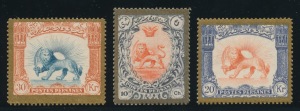Iran is not just a political pariah; it is a philatelic one as well. From an interest point of view, the stamps of Iran should be popular. The first issues, called the Lions (after the Shah's royal seal) are interesting with many rarer shades and varieties and types. And the post-1930 issues are well designed with an exotic flavor that should appeal to philatelists worldwide. There are many long definitive sets with rare high values. The country has oil wealth, and its national income should be increasing. The people of Iran are increasingly well educated and should begin to fit the collecting demographic that has propelled the stamps of China, India, and Russia. And there is a wealthy, educated, and successful Iranian expatriate community, another good indicator of philatelic popularity.
Iranian philately suffers from two main problems. The first is the problems caused by Iran's political stances. Iran is currently under severe international economic sanctions. When people can't export money out of a country, there is no way that they can participate in the international philatelic markets. The home market suffers as no new material comes in, and the market for the stamps internationally suffers too as there is no native demand to drive prices and interest. Add to that, despite great oil wealth and a well educated and hard working population, Iran has become much poorer in recent years due to economic sanctions. Iranians, who should be able to boast that they are entering the ranks of the true middle class, are finding it difficult to even feed their families. Poverty and philately are a poor mix, and indeed the poverty/wealth relationship is the greatest predictor of philatelic interest for a country. The unfortunate laboratory that proves this hypothesis is North Korea. Its population is ethnically identical to South Korea, and until fifty years ago the countries enjoyed similar economic success. As South Korea has become wealthy, its people have embraced philately. Virtually no one collects stamps in North Korea.
But it is not just poor economic conditions in Iran that have made the stamps of Iran unpopular. Iranian philately is unique in the number of forgeries and reprints that it has. From about 1880-1930, over fifty years, the Iranian Post Office had a series of scurrilous relationships with various stamp dealers and philatelic agents. The relationships differed from year to year and issue to issue. Sometimes postal agents sold issues out the back door. Sometimes they sold the plates and the philatelic brokers printed their own. Sometimes, entire issues were created solely for these brokers, and many of these imaginary stamps had catalog status until their true nature was known. They have since been winnowed out of the major catalogs. But the details of these arrangements matter less than their effect. The enormous number of Iranian forgeries and reprints in the fifty year period 1880-1930 has made the collecting of Iranian stamps unpopular. It is just too difficult to tell genuine from fake because many of these stamps are all printed from the same plates. Stamp collecting that is this difficult does attract a few hardy philatelists, but most collectors just collect something else.
Long term, the popularity of Iranian stamps could go either way. Iran could come back into the good graces of the West by abandoning its nuclear policy and its anti-western belligerence. If America drops its embargo of Iran, the popularity of Iranian stamps will increase (right now, the earlier stamps of Iran, including the beautifully designed and rare

